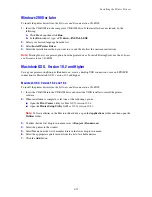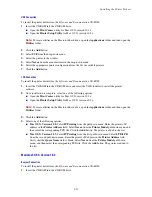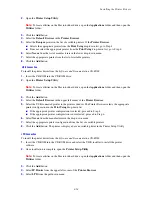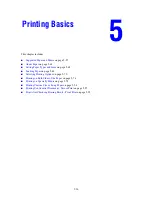
Choosing a Connection Method
4-45
Network Connection
Depending on your particular setup, the following hardware and cabling is required for Ethernet.
■
If you are connecting to one computer, an Ethernet RJ-45 crossover cable is required.
■
If you are connecting to one or more computers with an Ethernet hub, or cable or DSL router, two or
more twisted-pair (category 5/RJ-45) cables are required. (One cable for each device.)
If you are connecting to one or more computers with a hub, connect the computer to the hub with one
cable, and then connect the printer to the hub with the second cable. Connect to any port on the hub except
the uplink port.
See also:
Configuring the Network Address
on page 4-47
Installing the Printer Drivers
on page 4-51
Scanning to a Computer on a Network
on page 7-118
Scanning to Email
on page 7-123
Connecting via USB
If you are connecting to one computer, a USB connection offers fast data speeds. A USB connection is not
as fast as an Ethernet connection but is faster than using parallel. To use USB, PC users must have
Windows 2000, Windows XP, Windows Server 2003, or newer operating system. Macintosh users must use
Mac OS X, version 10.2 and higher.
USB Connection
A USB connection requires a standard A/B USB cable. This cable is not included with your printer and
must be purchased separately. Verify that you are using the correct USB cable for your connection (2.0 for
best results).
1.
Connect one end of the USB cable to the printer and turn it on.
2.
Connect the other end of the USB cable to the computer.
See also:
Address Book Editor
on page 3-41
Express Scan Manager
on page 3-41
Installing the Printer Drivers
on page 4-51
















































